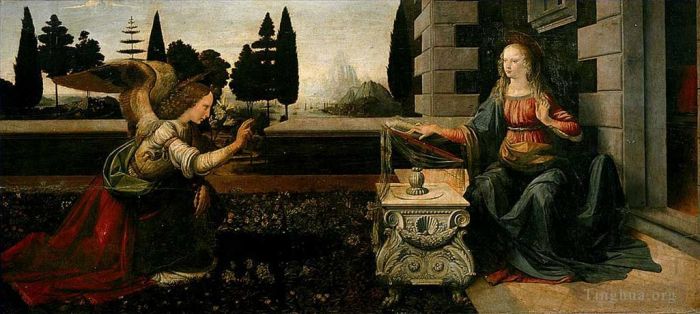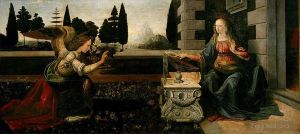The Annunciation
Leonardo da Vinci
- Price:
- Art Type: Oil Painting
- Size:
- English Comments: 0
- International Comments: 0
- Creating Date:
- Introduction and Works of Leonardo da Vinci >>
Keywords:
Annunciation
Work Overview
- Artist Leonardo da Vinci
Year circa 1472–1475
Medium Oil and tempera on panel
Dimensions 98 cm × 217 cm (39 in × 85 in)
Location Uffizi, Florence, Italy
Annunciation is a painting by the Italian Renaissance artists Leonardo da Vinci and Andrea del Verrocchio, dating from circa 1472–1475.[1] It is housed in the Uffizi gallery of Florence, Italy.
The subject matter is drawn from Luke 1.26-39 and depicts the angel Gabriel, sent by God to announce to a virgin, Mary, that she would miraculously conceive and give birth to a son, to be named Jesus, and to be called "the Son of God" whose reign would never end. The subject was very popular for artworks and had been depicted many times in the art of Florence, including several examples by the Early Renaissance painter Fra Angelico. The details of its commission and its early history remain obscure.
In 1867, following Gustav Waagen methods, Baron Liphart identified this Annunciation, newly arrived in the Uffizi Gallery from a convent near Florence, as by the young Leonardo, still working in the studio of his master Verrocchio.[3] The painting has since been attributed to different artists, including Leonardo and Verrocchio's contemporary Domenico Ghirlandaio. It was more recently determined to be a collaboration between Leonardo and his master Verrocchio, with whom Leonardo collaborated on the Baptism of Jesus.
The angel holds a Madonna lily, a symbol of Mary's virginity and of the city of Florence. It is supposed that Leonardo originally copied the wings from those of a bird in flight, but they have since been lengthened by a later artist.
When the Annunciation came to the Uffizi in 1867, from the Olivetan monastery of San Bartolomeo, near Florence, it was ascribed to Domenico Ghirlandaio, who was, like Leonardo, an apprentice in the workshop of Andrea del Verrocchio. In 1869, Karl Eduard von Liphart, the central figure of the German expatriate art colony in Florence, recognized it as a youthful work by da Vinci, one of the first attributions of a surviving work to the youthful Leonardo.[4] Since then a preparatory drawing for the angel's sleeve has been recognized and attributed to Leonardo.
Verrocchio used lead-based paint and heavy brush strokes. He left a note for Leonardo to finish the background and the angel. Leonardo used light brush strokes and no lead. When the Annunciation was x-rayed, Verrocchio's work was evident while Leonardo's angel was invisible.
The marble table, in front of the Virgin, probably quotes the tomb of Piero and Giovanni de' Medici in the Basilica of San Lorenzo, Florence, which Verrocchio had sculpted during this same period. Some immature hesitancies are usually noted, especially the Virgin's ambiguous spatial relation to the desk and the marble on which it rests.
On March 12, 2007, the painting was at the center of a furor between Italian citizens and the Minister of Culture, who decided to place the picture on loan to exhibit in Japan.
------------------------------------------------------
Leonardo's early painting of the Annunciation owes much to the influence of his master, Andrea del Verrocchio. However it is considered to be da Vinci's first major work, a large painting executed by his own hand with, perhaps, the help of Verrocchio's workshop. In fact the attribution to Leonardo was only presented in 1867 and the debates about the parts actually painted by him continued for a long time.
Importantly certain aspects of the painting such as the composition, the Archangel Gabriel and the landscapes are pure da Vinci but agreement on many aspects of attributions remain far from unanimous. Some details of the painting, such as the wings of the angel, have been repainted by another hand and the marble sarcophagus has been copied from a carving by Leonardo's master, Andrea del Verrocchio. For several years the painting was thought to be the work of Domenico Ghirlandaio, or Lorenzo di Credi, Credi was apprenticed to Verrocchio's workshop at the same time as Leonardo.
It is feasable that the work is a colaboration between several artists with the finishing touches completed by Leonardo.
The story of Mary being visited by The Archangel Gabriel, who explains that she is destined to be the mother of the Son of God, was a popular one in renaissance times.
Gabriel is kneeling in the garden of the Virgin. There is a respectable distance between the Angel and Mary, who receives his news sitting at a reading desk. The angel holds a Lilly in his left hand, a symbol of Mary's purity, his right hand raised in greeting. A youthful Mary is presented in a three-quarter view, she appears to be shrinking away from the angel, her body turned towards the viewer.
The landscape and the atmospheric depiction of the elements, the mountains and water in the background, are early indicators of a theme that Leonardo was to use in many later works.
--------------------------------------------------------
The Leonardo da Vinci painting The Annunciation painted on oil and tempera on a 98 cm by 217 cm panel was originally attributed to another painter, Domenico Ghirliando. It was until 1869 when art experts from the nineteenth century recognized the painting style to be from the hand of the renowned Leonardo da Vinci executed in c. 1472 – c. 1475. The painting was perhaps made as an altarpiece and it was housed in the Convent of San Bartolomeo of Monte Oliveto just outside Florence, Italy until 1867 when the painting came to Uffizi.
There are two versions of the painting, one in Uffizi Gallery in Florence and the other in the Louvre Museum in Paris. The Uffizi version was the one first attributed to Ghirliando. The Louvre version was thought to be painted in c. 1478 – c. 1485. Both paintings are pronounced as made by Leonardo da Vinci although the Louvre version was doubtfully made by him according to experts.
The painting illustrates the Archangel Gabriel on his knees with his right hand raised towards Mary in greetings in the Florentine palace garden. Mary is depicted with her left hand gesture in response to the archangel’s greeting. The painting of Mary is in her three-quarter form sitting on a chair outside a room. The height, width and depth of the painting all meet in Mary’s spot and with Mary’s body outlined by the house’s cornerstones and her head emphasized by the dark wall. Mary’s importance is signified in the painting. The background landscape depicts tress and mountains under a grey and foggy sky.
The painting was recognized by the experts as made by the young Leonardo da Vinci because of the unmistakeable painting style of the artwork, especially with the details of draperies and clothing and the painting approach and atmosphere of the background. The ‘Leonardesque’ effect is seen with the shadows and lighting effects of the shading clearly seen in the painting.
---------------------------------------------------------
The Annunciation was painted by Leonardo da Vinci round 1475-1480.
One of the main, typical traits of the genius Leonardo da Vinci – a painter, inventor, military engineer, astronomer, architect - was “introducing” and “reproducing” nature inside his works of art.
Just to have an idea, please notice the wings of the Archangel Gabriel announcing Mary she will be the mother of Jesus: here are real bird wings, not just an artistic representation of them!
Science within art, art within science, this is the great, charming characteristic of Leonardo da Vinci.
---------------------------------------------------------
The Annunciation depicts the moment when the angel Gabriel appears before Mary. The enclosed garden symbolises her virginity.
Two versions of this painting exist. The one in the Uffizi gallery is more likely to be Leonardo's own. A second version, which hangs in the Louvre could well be the work of Lorenzo di Credi, who, like Leonardo was also an apprentice of Verrocchio. However, the Louvre version also contains elements - such as realistic wings on the angel - which we associate with Leonardo's style.
This painting contains technical flaws which we would not expect from a Leonardo work. However, it was painted when Leonardo was still young. These errors may be because he was still learning his craft.
- Copyright Statement:
All the reproduction of any forms about this work unauthorized by Singing Palette including images, texts and so on will be deemed to be violating the Copyright Laws.
To cite this webpage, please link back here.
- >> English Comments
- >> Chinese Comments
- >> French Comments
- >> German Comments
- >>Report
- Leda 1508
- Portrait of a musician
- The Virgin of the Rocks 1491
- Madonna and Child with Flowers (Benois Madonna)
- The Annunciation
- Madonna and Child with a Pomegranate
- Portrait of Ginevra Benci
- La belle Ferroniere
- Baptism of Christ
- St John the Baptist
- St John in the Wilderness (Bacchus)
- Madonna Litta
- Leda 1530
- The Virgin and Child with St Anne
- Madonna with the Yarnwinder 1501
- Madonna with the Yarnwinder after 1510
- Saint Jerome
- Leda 1510
- Portrait of Cecilia Gallerani (Lady with an Ermine)
- Leda and the Swan 1505
- The Madonna of the Carnation
- Mona Lisa
- Vitruvian Man
- Design for St Anne
- Study of a womans head
- Allegory with wolf and eagle
- Battle of Anghiari Tavola Doria
- Study of a rider
- Study for the Last Supper Judas
- Rearing horse
- Study sheet with horses and dragons
- Madonna and Child with St Anne and the Young St John detail1
- Studies of human skull
- Study for Madonna and Child with St Anne Drapery over the legs
- Study of hands
- Anatomical studies of the shoulder
- Star of Bethlehem and other plants
- Battle of Anghiari
- Drawing of the Torso and the Arms
- Adoration of the Magi
- Study of St Anne Mary and the Christ Child
- Ceiling decoration
- Study of horses
- Studies of Leda and a horse
- Womans Head
- Study for the Last Supper
- The Last Supper
- Landscape drawing for Santa Maria della Neve on 5th August 1473









 Singing Palette
Singing Palette